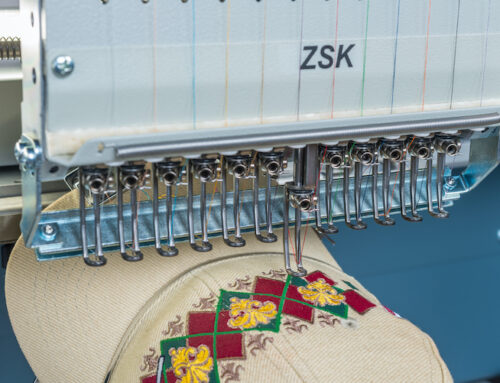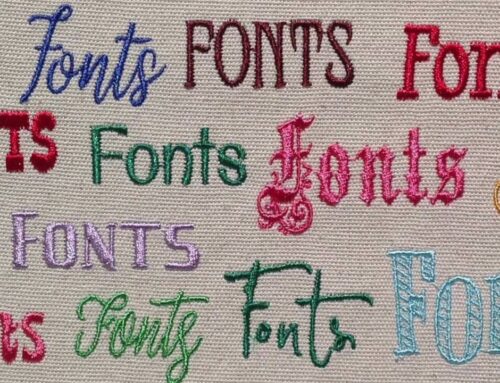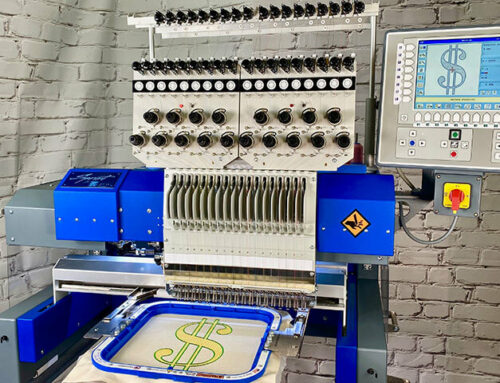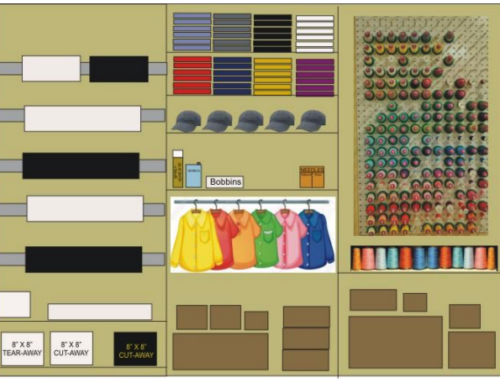A financial guide to help you start and succeed with your embroidery business

This guide will help you prevent common mistakes that could cost you big when running your home embroidery business. Instead, let’s start you on the right track so you can make money!
Whether your embroidery business starts slow, or you have plenty of orders to fill, one thing will eventually happen. You’ll reach a point where you begin to grow more than expected. This is the testing moment for most businesses — how they handle the growth.
You might have all the right systems in place, emails sent, designs stored, but if your money management isn’t right, the business will eventually crumble.
Whenever someone starts a business, it doesn’t come with the perfect financial plan. You have to create it yourself. Some don’t take this seriously, and what could have been a profitable business will come crashing down when it’s tax time, or when there isn’t enough cash left over to pay the expenses.
If you don’t have an embroidery business but are interested in starting one, check out our 5 crucial steps for how to start an embroidery business and our guide on How to Set Up Shop for an Embroidery Business. Turning your hobby into a business is easier than you think.
How to start making money with your embroidery machine (boost your income)
Here are a few not so secret mistakes to avoid when starting out:
1. Not having a separate bank account
This might be the worst mistake a business owner could make. The last thing any business owner wants is to lose track of profits, expenses, and tax allocations. When your personal account is used as your primary business account, things get messy — fast.
When your business money gets mingled with your personal money, it isn’t easy to draw the line when paying yourself or other expenses. It’s challenging to accurately keep track of funds used for yourself and funds necessary for your business’s survival.
Even if you create a spreadsheet and calculate every penny, you’d be wasting too much time. Time that could be better spent, say, embroidering.
Pay a visit to your local bank. Shop around for business accounts and find the best rates. Any money you earn from your business should be going into your business account and not directly into your pocket. You will need to allocate percentages of your earnings to different financial categories for your business, which leads us to the next mistake.
2. Not properly allocating your funds
Even if you create a separate business bank account, you’ll still need to manage your income and break it into portions. This is a point of failure for many businesses once they begin to grow. They aren’t properly allocating the funds earned, spending too much or too little in certain areas like taxes or payroll.

Mike Michalowicz, the author of Profit First, writes about an excellent strategy for dividing your earnings for your business’s various needs. It is a tried and true concept that has brought many companies out of a financial crisis.
Michalowicz says that a business owner should pay themselves first, allocating a portion of their earnings into a “profit” account immediately. However, this is not without first setting up separate savings accounts for other expenses.
Most banks allow you to have almost unlimited savings accounts linked to your main business account. This will enable you to create cash “buckets” for the core functions of your business. Michalowicz suggests creating at least five labeled:
- Income/ Revenue
- Owners Pay Account
- Operating expenses
- Taxes
- Profit
From there, any time you receive a payment, it would go directly into your Income/Revenue account. Then you can allocate the funds into the appropriate accounts based on percentages that suit you and your business needs.
It’ll be up to you to decide how much money needs to go into each account. For example, the Operating Expenses account should have a percentage of income dropped into it that’ll cover your yearly costs, over time.
You’ll need to set up a system. How often do you allocate the funds? Once or twice a month? At the beginning and middle? Or middle and end? These are all things that you will need to sit down and work out.
The profit account will likely get a tiny percentage to start. Mike suggests up to 5% of your earnings. Every quarter you can pay yourself a little bonus, or use the money to knock down debt.
The point is that it’s crucial to manage your cash flow from the beginning properly. Don’t overlook the importance of having a sound financial foundation from which to grow.
3. Not setting money aside for taxes
We touched on having a tax account earlier. Although many small embroidery businesses may start as cash only, this is extremely important to keep in mind especially as you grow. Whether you’re a sole proprietor or a limited liability corporation, You’ll always need to pay your taxes. Depending on your earnings, you’ll fall into a tax bracket category, typically starting at 20% and moving up from there.
It’s vital to understand that a percentage of every dollar you earn belongs to the government and not you. Treating it as the government’s money and setting it aside will save you many headaches and possibly legal trouble.
When tax time rears its ugly head, you’ll be prepared to pay your taxes. The last thing you want is to sit there, gripping your temples, wondering whether you should dip into your personal savings account to pay the taxman.
4. Quitting your day job too early
For some of you, machine embroidery will always be a side job, and that’s okay -It’s how you like it. For others, you’ll want to grow and expand your business to do what you love every day. It’s hard to know when, if ever, there is a perfect time to leave behind a stable income and focus entirely on the business.
Your business must be able to support you on its own before you can make the leap. Of course, once you begin to work on your home embroidery business full time, you gain time to work more and make up the extra cash you need. Check out our 5 tips to maximize your profit for your embroidery business here. It’s important to remember that your business’s success and profitability rely on the systems you put in place.
An excellent way to hedge your bet is to build-up a “runway.” In business, this refers to an amount of money that could carry you through a few months of operation if your business is making little or no money.

Calculate how much money you would need to survive for six months without earning anything. Take the time to save up that amount of cash, and when you are ready, you can leap to working on your business full time.
The “runway” will be there if you experience a few slow months, or while you ramp things up in your business. Remember, the runway is there to support an already functioning business. It wouldn’t be wise to create a runway, then quit your job and start a business.
5. Wasting money on “good” investments
The best thing you can do for yourself when running a machine embroidery business is making sure you have high-quality equipment and proper training.
As Benjamin Franklin once said:
“An investment in knowledge pays the best interest.“
That statement is as true today as it was back then. That’s why you’re reading this article. That’s why you want to learn everything you can about machine embroidery, even the business side.
You can spend your hard-earned dollars on embroidery books and magazines — that’s fine. But what’s really going to pay off is an investment into a course that’s going to show you the ropes, from people who have a lifetime worth of experience in the industry.
Have a look at our How to Make Money with Embroidery Workshop. This workshop includes 6.5 hours of education, 8 different lectures, a 33-page “Cheat Sheet” PDF, and the ability to rewatch at your convenience. We’ll help you discover how to start and run an embroidery business successfully and how to turn your embroidery machine into a profit center. Our course will help you become the successful embroiderer you’ve always wanted to be.
Another important investment is your machine. This is where some people will try to save money, only to be burned by this decision in the long run.
Your machine is the most critical tool in your embroidery business. Do you have the right machine for your home business? Read the several factors you should know to choose the best embroidery machine for your home business.
Every second that your machine is down is a second that you have a client waiting.
6. Not automating parts of your home business
It’s easy to grab a pen and scrap of paper to jot down some numbers or record someone’s contact information. It’s not easy to find that piece of paper two weeks later when you need to figure out what you paid for thread or the details of an important bulk order.
It’s no secret that email is crucial for almost any business to survive in this day and age. Many small business owners and entrepreneurs aren’t aware that things like a Customer Relationship Manager, or CRM, exist.
Here’s how they work: Once you set up a business email, you can connect it to a CRM like Hubspot. It’s completely free and will track all of your clients and tasks in one place. You can leave notes and reminders pinned to your client’s email to remind you of a task or follow up.
This is an excellent tool in helping us avoid human error and forgetfulness. There will come a time when you’ll have an old client return to you for another project. You’ll scratch your head trying to recall the previous order and their preferences, or what they were like to work with.
A CRM allows you to record all of this information. The next time they reach out to you, you’ll have a detailed list of all the times you’ve contacted each other, what you’ve talked about, and when you should contact them again.
7. Not helping your accountant (and therefore your business)
Another essential piece of software to incorporate into your business is a digital bookkeeper, like Quickbooks, or GoDaddy Accounting. Writing things down is nice, but let’s face it, it’s a thing of the past. You need well-recorded data. If it doesn’t get measured, it doesn’t get managed.

Inputting all of your financials into an accounting software will save you enormous amounts of work and headache when tax season rolls around. These days, the software is capable of doing all of the tedious and complicated equations for you.
You’ll get beautiful pie graphs and charts showing you how your business is spending money. This will give you a much clearer picture of your financial health. It’s still a good idea to have a professional accountant look over your numbers. Your accountant will breathe a sigh of relief when you come in with a laptop and your calculations ready and not a folder as thick as an old encyclopedia.
Apply these financial tips to your embroidery business… If possible, when you first start
Using these financial tips will help you handle your business’s growth by creating the perfect financial plan.
Opening separate bank accounts is a great way to keep track of your funds and where they’re going, and properly allocating your funds is essential for proper management of your income. Setting aside money for taxes is crucial as a certain percentage of your money always belongs to the government. It’s also important not to use this business as your main income source until you have good savings to carry you through financial uncertainty. Use your money on good investments, such as a good machine or proper training that’ll help make you more profitable.
We also suggest automating your business to properly document your clients and their information, making you more organized and professional. Finally, we recommend helping your accountant by inputting your financials into accounting software; this way, everything is managed correctly and documented.
In the end, a business is as much about the systems you have in place as it is about the work. Every good embroiderer who wants to go into business must value the importance of a sound financial foundation to sew- pardon the pun- the seeds of success for the future.
P.S. Want to learn some of the industry’s top embroidery business secrets to maximize your profits? We’ve partnered up with the NNEP (National Network of Embroidery Professionals) to launch a new How to Make Money with Embroidery Workshop! This 6.5 hour workshop will go far beyond the basics we mentioned in this article and show you some proven advanced techniques that’ll help skyrocket your success and increase your profits! Click here to learn more now.






Excellent article thank you.
Thanks for reading Karen